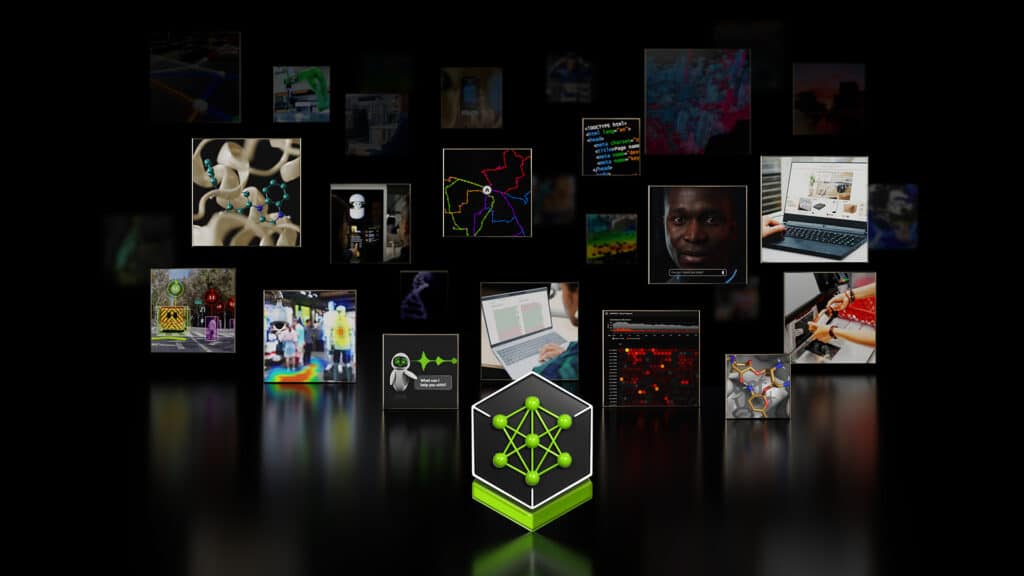The first three NIM Agent Blueprints are workflows for customer service, accelerated drug discovery, and a multimodal PDF data extraction.
When AI was first introduced on a mass scale, it was shown as Generative AI accessed through web-based applications. Now, Generative AI models are making their way to businesses. AI models like Google Gemma, Llama 3.1 405B, Microsoft Phi, Mixtral, and Nemotron develop business-specific AI applications to support growth and increase productivity.
Originally launched in June, NVIDIA NIM offers a standardized method for integrating generative AI into applications. It’s a collection of customizable AI workflows designed to streamline enterprise developers building and deploying their own generative AI applications on NVIDIA GPUs—anywhere: in the cloud, data centers, workstations, and PCs. However, developing AI applications is still challenging. That’s why NVIDIA launched NIM Agent Blueprints. NVIDIA NIM Agent Blueprints offer pre-trained models and reference codes for specific use cases like customer service, data extraction, or medication development.
AI Microservices and Flywheels, oh my!
Developers can create applications using NIM’s AI tools and microservices and hit the ground running. The blueprints allow developers to adjust and enhance workflows using information retrieval and agent-based workflow to perform complex tasks. Moreover, an AI application continues to train and refine itself.
NVIDIA NeMo, an end-to-end platform for developing generative AI anywhere, facilitates connecting models to their data for training. The model’s continuous learning cycle creates a generative AI Flywheel, a self-reinforced cycle that creates better AI by utilizing user data. NIM Agent Blueprints assist businesses in creating AI Flywheels using NVIDIA NeMo Retriever, a NIM microservice.
With NVIDIA AI Foundry, a platform and service for building custom generative AI models with enterprise data and domain-specific knowledge for running the Flywheel, NVIDIA believes companies could create AI assistants tailored to specific jobs and tasks using retrieval-augmented generation (RAG) and agent-based architectures.
NVIDIA Founder and CEO Jensen Huang stated, “Generative AI is advancing at lightspeed.” He said, “Frontier model capabilities are growing exponentially with a continuous stream of new applications. The enterprise AI wave is here. With the NVIDIA AI Enterprise toolkit — including NeMo, NIM microservices and the latest NIM Agent Blueprints — our expansive partner ecosystem is poised to help enterprises customize open-source models, build bespoke AI applications and deploy them seamlessly across any cloud, on premises or at the edge.”
Partnerships
NVIDIA and a whole “ecosystem” of partners have contributed to the NIM Agent Blueprints. Systems Integrators and service delivery partners like Accenture, Deloitte, SoftServe, Quantiphi, and World Wide Technology (WWT) are working to roll out NIM Agent Blueprints to businesses globally. Partners create tools leveraging customer interaction data to optimize a multitude of aspects.
NIM Agent Blueprints can integrate with data and storage platforms from partners, such as Cohesity, Datastax, Dropbox, NetApp, and VAST Data. Partners like Dataiku and DataRobot use blueprints for model fine-tuning, governance, and monitoring. While Deepset, LlamaIndex, and Langchain use them to build workflows. Weights and Biases leverage blueprints for generative AI application evaluations. CrowdStrike, Fiddler AI, New Relic, and Trend Micro can be used for safeguarding.
Conclusion
The first three NIM Agemt Blueprints available are digital human workflows for customer service, a generative virtual screening workflow for accelerated drug discovery, and a multimodal PDF data extraction workflow for enterprise RAG. NVIDIA says they will have monthly releases of new NIM Agent Blueprints, like customer service, content generation, software engineering, retail shopping advisors, and R&D.
Developers on NVIDIA platforms can now create models that securely and effectively handle company and customer data, which is a win for AI integration. Plus, the self-learning aspects of the Flywheel could free up developers’ time. With NIM Agent Blueprints, there is little stopping enterprises from integrating AI into anything. Jensen Huang said, “The enterprise wave of AI is here.”
Engage with StorageReview
Newsletter | YouTube | Podcast iTunes/Spotify | Instagram | Twitter | TikTok | RSS Feed



